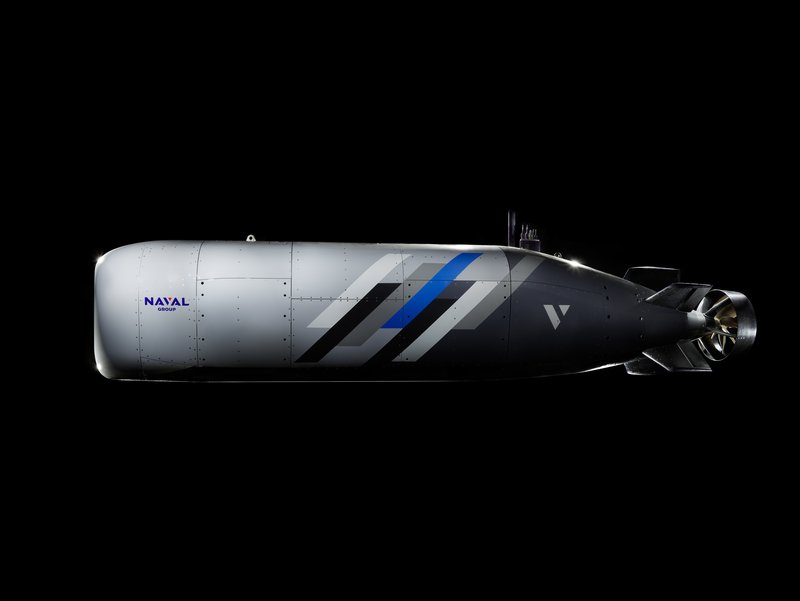Ready for action? Unpicking France’s plans for an armed UUV
In December 2023, the French DGA procurement agency awarded Naval Group a framework contract for the design, production and testing of an unmanned combat underwater vehicle (UCUV). Very little is known about how the French Navy will deploy this system, but the fact that it is based on Naval Group’s XL UUV demonstrator provides some hints.
The UCUV framework agreement followed another contract awarded to Naval Group by the DGA in May 2023. This focused on a study, carried out over nine months, to understand the main use cases and system architecture of a UCUV... Continues below
Newsletter Sponsor:

Above: The UCUV to be developed by Naval Group will draw heavily on the company’s XL UUV demonstrator. (Photo: Naval Group)
The latest contract will build on that study and start exploring the different technological bricks that could fit the French Navy’s operational requirements for such a system. The first phase kicked off with a follow-on contract signed in December 2024 covering 24 months of work.
This will focus on enhancing the UCUVs decision-making autonomy by developing a ‘brain’ allowing the system to navigate safely, known as Autonomous Decision-Making Process (ADMP).
The key objective, at this stage, is to facilitate mission planning and monitoring, as well as ensuring safe surface and underwater navigation. These functions are essential for an autonomous, resilient and multi-mission system.
To date, very little is known about the system beyond some basic facts.

Schiebel – leading the unmanned evolution
According to Naval Group, the UCUV’s architecture will be based on the company’s XL UUV demonstrator or Démonstrateur de Drone Océanique (DDO), although it will be bigger.
The DDO weighs 10t and is 10m long and 2.3m wide. It is capable of carrying different sensors and payloads – from bow-mounted sonar and flank antennas to ROVs and small UUVs.
The author reached out to Naval Group to ask about the different concepts of operations (CONOPS) identified during the first study from 2023, but the company could not comment due to the confidential nature of the information.
That being said, the fact that the name of the uncrewed system changed from XL UUV to UCUV (with a C for combat) is already an indicator of where things may be heading.
Other articles in this newsletter:
Is nowhere safe? Countering the threat to naval vessels at their home ports
Hard to foresee – why predictive maintenance for naval vessels may never be comprehensive
In fact, the DDO was already designed for easy integration of weapons, such as mines and torpedoes.
Perhaps even more tellingly, the ADMP has been developed to allow the uncrewed system to continue carrying out its mission(s) in all circumstances, even when communications with crew aboard another ship or onshore are no longer available.
Although this feature may sound similar to what is already being developed in the context of mine countermeasures (MCM), there is an important difference: the ADMP enables autonomous systems to become multi-mission assets.

Above: The UCUV evolved from the DDO will be able to reconfigure its mission according to its own analysis of the tactical situation. (Image: Naval Group)
Using information gathered from all onboard sensors, the UCUV could potentially reconfigure its mission in response to any contingency emerging in its area of operations.
In other words, beyond obstacle avoidance – an algorithmic achievement that is now relatively well-proven – the ADMP will allow UCUVs to reconfigure themselves according to their own analysis of the tactical situation.
It would do so within the parameters set out for the mission and follow the behavioural rules and room for manoeuvre programmed into the ADMP. This will be possible even when multiple UCUVs are deployed simultaneously or as part of a wider task force.
Over the next 24 months, Naval Group told the author that it will primarily focus on two main phases (including the one that just started): further development of the ADMP to perfect the UCUV capability; and testing of various technological bricks on the DDO to improve endurance, underwater detection and the ability of the UCUV to deploy other smaller uncrewed systems.
The latter aspect will include studies on various propulsion and battery systems. In fact, drawing on its know-how and experience of submarines, Naval Group is studying a solution for recharging batteries using an electro-hydrogen unit equipped with a fuel cell.
From a wider geopolitical point of view of course, the French Navy, one of Europe’s largest, cannot afford to ignore the fact that other nations are developing maritime uncrewed systems that can be armed.
Don't want to miss out on future Decisive Edge content? Make sure you are signed up to our email newsletters.











